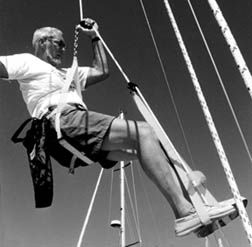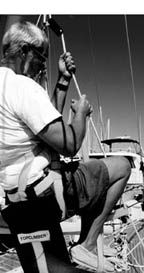Figuring the best way to get to the masthead is one of those conundrums seldom resolved. If you’re one of the rare sailors who hasn’t considered the problem, ask yourself, “What do I do if the genoa halyard jams and I can’t get the sail down…and the wind is picking up?”

Or a piece of standing rigging needs attention or the VHF antenna has failed or…the possibilities are endless.
The traditional means of ascending the mast is by bosun’s chair, halyard and crew grinding a deck-mounted winch (use of a mast-mounted winch is not recommended as fasteners have very little thread in the mast wall). As implied, it requires at least two persons, three if the winch grinder needs help tailing the halyard. If you’re the person in the chair, you worry about the grinder letting go…for whatever reason.
In recent years, Practical Sailor has evaluated bosun’s chairs (January 15, August 15, 1993), as well as various alternative means. Mast ladders made of polyester webbing that are hoisted up the mainsail track—Mast Mate and Captain Al’s—were tested in the March 1, 1994 and August 15, 1998 issues. Mast steps were described in the July 1, 1998 issue. Each has its advantages and disadvantages. To hoist a ladder, the mainsail first needs to be lowered, possibly with slides removed. Mast ladders and steps require that one’s hands be used to climb or hug the mast and so are not free for work.
Also in the August 15, 1998 issue we discussed a product called the Mast Lift as well as a bosun’s chair and tackle used by professional riggers to haul themselves up the mast without assistance. Often they must work alone; and even when help is available, many riggers prefer to trust in themselves. The Mast Lift is a drum with reel inside that is hoisted to the masthead by a halyard; a line is paid out of the drum and kept on deck. The device worked well but is expensive and, unfortunately, the importer had serious difficulties delivering product to customers who had already paid.

So, we were more than a little interested to learn of the Topclimber, a solo system imported and distributed by Etienne Giroire. A former single-handed racer, Giroire’s ATN company specializes in labor-saving devices for sailors, including the ATN Spinnaker Sleeve, the Gale Sail and Tacker, all of which we’ve tried on our test boats. Quality of each is very good.
Giroire did not invent the Topclimber, but he did make an important modification to it, he told us, which, visible in the photo, is the short length of chain between the harness and top jammer so one can better work at the masthead.
Rather than using one’s arms to hoist himself, the Topclimber uses leg power; the legs are, after all, much stronger. The system consists of a bosun’s chair with safety strap, stirrups, and two one-way line jammers on their own 7/16″ dedicated line. The straps and stirrups are made of yellow webbing.
We tried the Topclimber and found it a bit awkward at first. Giroire readily admits it takes a few tries to get the motions down. Here’s what you do:
1. Hoist the line to the masthead with a halyard and make fast.
2. Step into bosun’s chair and secure safety straps.
3. Move upper jammer to about head level; you do this by pressing a bar that releases the spring-loaded cam.
4. Bend your knees and lift them so that you can also raise the lower jammer to about waist level.
5. Stand up.
6. Raise upper jammer again.
7. Sit down.
8. Raise lower jammer.
9. Stand up.
Repeat this process until you’re where you want to be. To descend, the process is simply reversed. It’s a kind of herky-jerky operation at first, but as soon as you have the steps memorized you can move surprisingly quickly. The best part is you’re not exhausted when you make the masthead, as you’re likely to be using arm strength.
There are some other tricks that help, like keeping your feet pressed against the rope so that you don’t spin around, but overall we think this is a safe, economical way to get oneself aloft. The one-way jammers replicate the features of the Saf Brak that we extolled in our earlier pieces. And we like not having to worry about the reliability of crew on deck grinding a winch.
The Topclimber comes with a tool bag and sells for $285.
Contact- ATN, 1509 SW 1st Ave., Ft. Lauderdale, FL 33315; 800/874-3671.






































